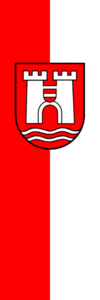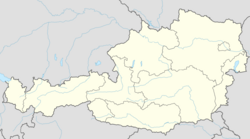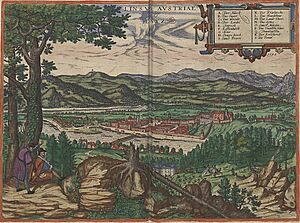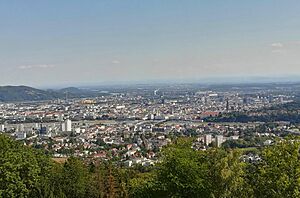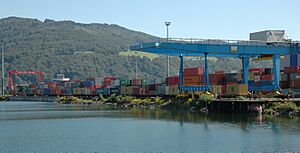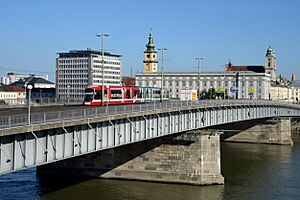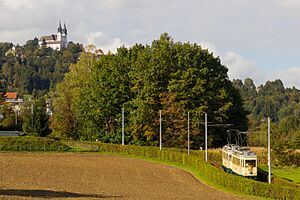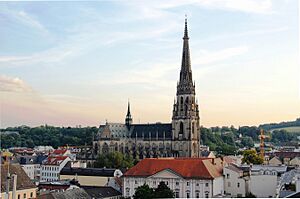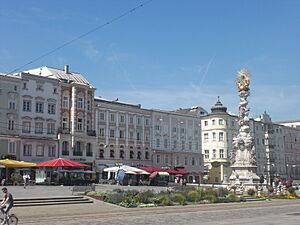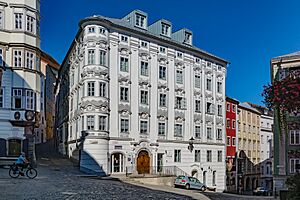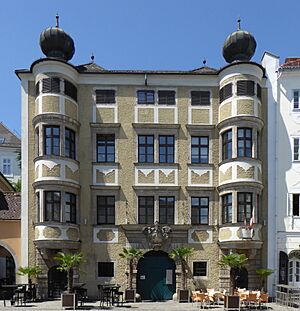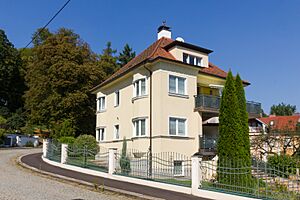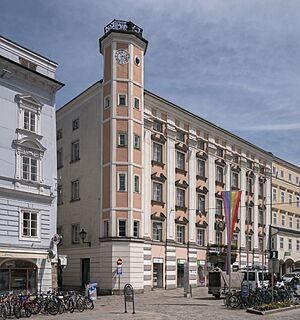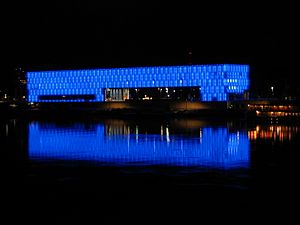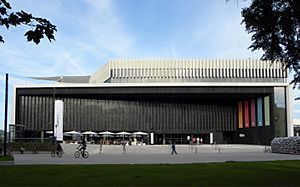Linz facts for kids
Quick facts for kids
Linz
|
|||||
|---|---|---|---|---|---|
|
Clockwise from top: general view with the New Cathedral, pedestrian area in the city centre, Landstraße, Altstadt
|
|||||
|
|||||
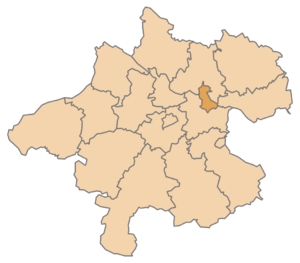
The city’s territory, highlighted on a map of Upper Austria, with the borders of the surrounding districts visible.
|
|||||
| Country | Austria | ||||
| State | Upper Austria | ||||
| District | Statutory city | ||||
| Elevation | 266 m (873 ft) | ||||
| Population | |||||
| • Metro | 271,234 | ||||
| Time zone | UTC+1 (CET) | ||||
| • Summer (DST) | UTC+2 (CEST) | ||||
| Postal code |
4010, 402x, 4030, 404x
|
||||
| Area code | 0732, (also 070 until 12 May 2014) | ||||
| Vehicle registration | L | ||||
| Website | https://www.linz.at | ||||
Linz (pronounced LINTS) is a major city in Austria. It is the capital of Upper Austria. Linz is also the third-largest city in the country. It sits right on the Danube River. The city is in the northern part of Austria. It is about 30 kilometers (19 miles) south of the Czech Republic border. As of early 2024, over 212,000 people live in Linz. It is the 7th largest city along the Danube River.
Contents
Discovering Linz's Past
How Linz Began
Linz started as a Roman fort. It was called Lentia. This fort was built in the first century. Its name comes from a Celtic word meaning "bendable." This refers to its location on a bend in the Danube River. The fort was important for protecting a key travel route.
The name "Linz" was first written down in the year 799. It became a fortified city in 1236. Linz was given official city rights in 1324.
Famous People and Discoveries
Johannes Kepler was a famous mathematician. He lived and taught in Linz for many years. On May 15, 1618, he made a big discovery here. He found out about Kepler's laws of planetary motion. These laws explain how planets move around the sun. The local university, Johannes Kepler University Linz, is named after him.
Around the year 1800, Linz was described as a well-built city. Its economy was growing. This was partly because of its location on the Danube. It also had good connections to Hungary and Vienna. At that time, about 16,000 to 17,000 people lived in Linz.
Early Industries in Linz
Linz had important industries. They made gunpowder, iron, and steel. Salt and firewood were also big products. But the wool industry was the most important. A large wool factory started in 1672. It was the biggest in Austria back then. The government took it over in 1754.
By 1800, this factory made a lot of money. It employed about 30,000 people.
Anton Bruckner was a composer and organist. He worked in Linz from 1855 to 1868. He played the organ at the Old Cathedral, Linz. The Brucknerhaus concert hall is named after him.
Linz During World War II
Adolf Hitler spent his childhood in Linz. He always thought of Linz as his hometown. During World War II, Linz became a huge industrial center. It helped the Nazi war effort. A large factory complex, Voest, was built here. Sadly, slave labor was used to build it. Some sub-camps of the Mauthausen concentration camp were located within this complex.
Linz was bombed during the war. After the war, many streets were renamed. This was to remove names linked to the Nazi era.
Linz's Economy Today
Linz is a major economic hub in Austria. Voestalpine is a big company here. It makes technology and industrial goods. It started during World War II. Now, it is known for its steelmaking methods. The former "Chemie Linz" chemical company has split into several businesses.
Linz is also a popular place for meetings. It is the third most important city for congresses in Austria. It has over 60 places for events. The city promotes "Blue Meeting" concepts. These focus on being eco-friendly. They support reducing waste and saving energy.
Danube Harbor and Trade
Linz has one of Austria's four Danube harbors. This makes it a great place for shipping and trade. Many factories are located along the river. Trade has been important to Linz for centuries. Large industrial companies, like Voestalpine AG, are still here.
Shopping in Linz
Linz has thirteen shopping malls. Three of them are in the city center. The Landstraße is a very busy shopping street. It is the busiest outside of Vienna. Many people walk along it every week.
Local Markets
Linz has eleven farmer's markets. There is also a weekly flea market. Two Christmas markets open each year. The "Urfahraner Markt" happens twice a year. These markets offer many different products. They help the local economy.
Getting Around Linz
Airport and Trains
Linz Airport is about 14 kilometers (9 miles) southwest of the city. You can easily get there by bus or shuttle. The airport has flights to cities like Frankfurt and Vienna. There are also seasonal flights to sunny places like Mallorca.
Linz has a central railway station. It is called Hauptbahnhof. This station is on Austria's main rail line. It connects Vienna with western Austria, Germany, and Switzerland. It has been named Austria's most beautiful train station many times.
Public Transportation
Linz has a good public transport system. It includes trams, trolleybuses, and buses. All are run by Linz AG. The tram network includes the Pöstlingbergbahn. This is a very steep tramway. It climbs a small mountain on the edge of the city.
People of Linz
Linz is home to many people. The city itself has over 212,000 residents. The larger urban area includes parts of 13 other towns. This area has about 271,000 people. Linz is part of a bigger metropolitan area. This area is home to about one-third of Upper Austria's population.
Many different nationalities live in Linz. The largest groups of foreign residents include people from Romania, Bosnia and Herzegovina, and Turkey.
Linz's Weather
Linz has an oceanic climate. This means it has warm summers. Winters are quite cold. The weather changes throughout the year.
Visiting Linz
In 2018, most foreign visitors to Linz were from Germany. Tourists from China were the second most common. Italy was third. Some restaurants and cafes are closed on Sundays.
Places to See in Linz
The main street is "Landstraße." It leads to the main square. The main square was built in 1230. It is one of Europe's largest squares. In the middle stands the "Pestsäule," or plague column. It is also called the "Dreifaltigkeitssäule" (Holy Trinity Column). It was built to remember people who died from the plague. It was finished in 1723.
Around the main square are many historic buildings. These include the Old Town Hall. The Feichtinger House has a carillon. This is a set of bells that plays different tunes.
West of the main square is the old quarter. It has many old buildings. Some are from the Renaissance period. Others are older with Baroque designs.
Near the Schloss (castle) is the oldest church in Austria. It is called Sankt Martins church. It was built a very long time ago, in early medieval times.
- St. Mary's Cathedral (Mariä-Empfängnis-Dom) is a Roman Catholic church. It is built in the Gothic-Revival style. At 134.8 meters (442 feet) tall, it is the tallest church in Austria. It was built between 1862 and 1924.
- Mozarthaus is a house from the late 16th century. The famous composer Wolfgang Amadeus Mozart stayed here. He wrote his "Linz" Symphony and "Linz" Sonata here in 1783. You can see the outside and the courtyard.
- Pöstlingberg-Kirche is a pilgrimage church. It is on the Pöstlingberg hill. This church is a landmark of the city. It was built from 1738 to 1774. It sits at 537 meters (1,762 feet) above sea level.
- Pöstlingbergbahn is a very steep mountain railway. It was built in 1898. It is one of the steepest in the world.
- Linzer Grottenbahn is a grotto railway. It is also located on the Pöstlingberg hill.
- Brucknerhaus is a concert and congress hall. It is on the Donaulände. It opened in 1973. The Brucknerfest festival has been held here since 1974. It is named after composer Anton Bruckner. The hall has great acoustics. It has a large organ with over 4,200 pipes.
- Gugl Stadium is home to the LASK football club. This club is one of the oldest in Austria.
- Linzer Landestheater is a regional theater.
- Kremsmünsterer Haus is in the "Alter Markt." Legend says Emperor Friedrich III died here.
- Landhaus was built in the 16th century. It is the main office for the governor. It also houses the Upper Austrian parliament. Johannes Kepler taught here for over 14 years.
Architecture in Linz
Linz has many small and sacred buildings. The Mariä Empfängnis Dom, or New Cathedral, is Austria's largest church by capacity. It is slightly shorter than Vienna's St. Stephen's Cathedral.
The historic center has a medieval style. Areas near the center have neoclassical and neo-baroque buildings. Further out, you find residential areas. Some buildings are called "Hitler buildings." They were built during the time of the Nazi dictatorship. The "Gugl" area became popular for wealthy people around 1900. Many villas are still there.
Newer buildings include the Linz Hauptbahnhof station. It was designed by Wilhelm Holzbauer. The station also has the Terminal Tower skyscraper. The Wissensturm ("Tower of knowledge") is about 63 meters (207 feet) tall. It holds the public library and an adult education center. The Lentos Art Museum opened in 2003. The Musiktheater (music theater) opened in 2013.
Culture in Linz
Linz has a lively music and arts scene. The city and state support it well. The "Donaulände" is a park along the river. It is between the Lentos Art Museum and the Brucknerhaus. It is also called "Kulturmeile" (culture mile). Young people often relax and meet here in summer. It hosts the Ars Electronica Festival in September. The "Stream Festival" also takes place here. In summer, musical groups perform for free at the "Musikpavillon."
Other cultural places include the Posthof and the Stadtwerkstatt. The Pflasterspektakel is an international street art festival. It happens every July in the city center.
Linz was the European Capital of Culture in 2009. It shared this title with Vilnius, Lithuania. The city wants to show its cultural diversity.
The Ars Electronica Center is a hub for media art. It draws many international visitors. The Valie Export Center is a new project. It is a research center for media and performance art. It holds the archives of artist Valie Export. Linz has two major archives for media art.
Since 2009, Linz has offered "Open Commons Linz." This provides free data about the city. There are also many free Wi-Fi hotspots. Linz is a leader in Europe for open data access.
Linz has 43 art galleries. It also has 13 cultural centers. There are four educational institutes for culture.
Museums to Explore
- The Lentos (built 2003) is a modern art gallery. It shows art from the 20th and 21st centuries. It is on the south bank of the Danube. The building can light up at night.
- Ars Electronica Center (AEC) is also called the museum of the future. It is on the north bank of the Danube. The AEC is a world center for new media arts. It hosts the Ars Electronica Festival. The AEC has the Deep Space 8K. This offers a unique virtual world. It has huge wall and floor projections.
- City Museum Nordico has art, history, and archeology collections. All relate to Linz.
- Upper Austrian Regional Museum (Oberösterreichisches Landesmuseum) has three main locations. The Landesgalerie shows modern art. The Schlossmuseum has archeological finds. The Biologiezentrum Linz-Dornach focuses on natural history. It has about 16 million objects.
- The Upper Austrian art association (Oberösterreichischer Kunstverein) holds art exhibitions.
- The Upper Austrian museum of literature (Oberösterrreischisches Literaturmuseum) is in the StifterHaus. Writer Adalbert Stifter lived here.
- The Upper Austrian forum for architecture (Architekturforum Oberösterreich) hosts lectures and exhibitions.
Music and Performance
The Brucknerhaus is a famous concert hall. It is named after Anton Bruckner. It is home to the "Bruckner Orchestra." It hosts concerts, balls, and other events. It is also a venue for the "Linz Fest."
The Musiktheater (music theatre) opened in 2013. It is one of Europe's most modern opera houses. It has five stages. The main hall has 1,200 seats. It hosts operas, operettas, ballets, and musicals.
The Landestheater (regional theatre) used to perform both music and theater. Now, only theater shows are at the "Promenade" venue. Musical shows are at the Musiktheater. The Landestheater Linz is known for its theater for young audiences, u\hof:.
The Posthof is a big event center. It has three rooms. It hosts about 250 events each year. These include concerts, theater, and dance. Local artists are often invited to perform.
The Stadtwerkstatt is a cultural association. It was founded in 1979. It hosts music events and other artistic activities. It also has its own café/bar.
Cinema in Linz
The first film was shown in Linz in 1896. Regular cinemas opened around 1908. Karl Lifka opened "Lifka's Grand Théâtre électrique." Johann Bläser opened the "Bio-Kinematograph." The "Kino Kolloseum" opened around 1910.
The Linz International Short Film Festival started in 2018. It focuses on international short films. It shows many films over four days.
Delicious Food in Linz
Linz has traditional restaurants and modern places to eat. You can find food from many different countries. Over 40 restaurants and cafes are part of "hotspots." Linz also has gourmet restaurants.
Typical dishes include the famous Linzer torte. This is a delicious cake. You can also find knödel (dumplings) and strudel (pastries). Another special food is erdäpfelkäs. This is a spread made from mashed potatoes and cream.
Fun Events All Year Round
- Ars Electronica Festival: This festival for media art happens every year. It includes exhibitions, concerts, and performances. It focuses on art, technology, and society.
- Bubble Days: This event happens every June. It features extreme sports shows. There are also art exhibitions and live music. Visitors can explore the harbor by boat.
- Christkindlmärkte: These are Christmas markets. They are held at Hauptplatz and Volksgarten.
- Crossing Europe Film Festival: This film festival takes place every year. It shows feature films, documentaries, and short films. It also has talks and live music.
- Donau in Flammen (Danube in Flames): This is an annual music fireworks show. It happens from June to August along the Danube.
- Höhenrausch: This is an annual art project. It started in 2009. It features international artists.
- International Brucknerfest: This music festival happens every September/October. It features classical music. It starts with the "Klangwolke."
- Kinderfilmfestival (Kid's Film Festival): This film festival is for children. Films are shown with live voice actors.
- Kinderkulturwoche (Children's Week of Culture): This week features plays and workshops for kids.
- Klangwolke (Cloud of sound): This open-air music event happens in September. It is free and attracts many people. It combines music with lasers, projections, and fireworks. There is also a special Klangwolke for children.
- Linzfest: This open-air festival happens every year. It is free and for all ages. It includes concerts, theater, and dance.
- Lido Sounds: A three-day music festival by the Danube.
- Pflasterspektakel: This street art festival happens every year. It features musicians, jugglers, acrobats, and clowns. It is one of Europe's biggest street art festivals.
- The Stadtfest (City festival) is held every August. It is a three-day festival. It has live music from national and international artists.
Archives and Gardens
- Archive of the city of Linz: This holds important documents about Linz's history.
- Atelierhaus Salzamt: This is a place for artists to live and work. It has ongoing exhibitions.
- Botanic garden: This garden attracts about 100,000 visitors each year. It has about 8,000 different plant types. It also hosts music and dance events.
- Donaupark Linz: This public park is along the Danube. It has sculptures by famous artists. Young people often meet here in summer. It also hosts the Linzer Klangwolke.
- Freinberg: A public park popular with families and joggers.
- Wasserwald: A large park in the south of Linz. It has walking paths, playgrounds, and a fitness trail.
- Stadtpark: A new city park opened in 2003. It is the second largest inner-city park.
- Linzer Zoo: The zoo is on Pöstlingsberg. It has about 600 animals from 110 different species.
- Kirchschlag bei Linz ski resort: This ski resort is 15 km (9 miles) north of Linz. It has three ski lifts. You can measure your speed or ski at night. It also has cross-country skiing and ice skating.
Donausteig Hiking Trail
The Donausteig is a long hiking trail. It is about 450 kilometers (280 miles) long. It is divided into 23 sections. It mainly follows both banks of the Danube River. It goes from Passau through Linz to Grein. The trail mostly runs through nature. It leads to many beautiful viewpoints.
Linz's City Forest
Linz has a large city forest. About 18 percent of the city is covered by forest. This is about 1,724 hectares (4,260 acres) of forest. The city owns about 500 hectares (1,235 acres) of this. These forests are managed to be sustainable. They provide recreation and help the environment.
Notable People from Linz
Many interesting people have lived in or come from Linz.
Public Service and Thinkers
- Mary Anne of Austria (1683–1754), a Queen of Portugal.
- Johann Amadeus von Thugut (1736–1818), an Austrian diplomat.
- Ute Bock (1942–2018), an educator who helped people seeking asylum.
- Volker Türk (born 1965), the United Nations High Commissioner for Human Rights.
Artists and Performers
- Anton Bruckner (1824–1896), a famous Austrian composer and organist.
- Alois Riegl (1858–1905), an art historian.
- Richard Tauber (1891–1948), an Austrian singer and film actor.
- Valie Export (born 1940), an important avant-garde artist.
- Franz Welser-Möst (born 1960), a music director for orchestras.
- Christina Stürmer (born 1982), a popular Austrian pop/rock singer.
Science and Business
- Julius von Hann (1839–1921), an Austrian meteorologist. He is seen as a founder of modern meteorology.
- Paul Achleitner (born 1956), a banker and businessman.
Sports Stars
- Elisabeth Theurer (born 1956), an equestrian who won a gold medal at the 1980 Olympics.
- Andreas Ulmer (born 1985), a footballer who has played many games.
- Mateo Kovačić (born 1994), a Croatian footballer.
- Xaver Schlager (born 1997), a footballer.
People Who Lived in Linz
- Adalbert Stifter (1805–1868), an Austrian writer, painter, and teacher.
- Adolf Hitler (1889–1945), a political leader who lived in Linz during his childhood.
Sister Cities Around the World
Linz has many sister cities. These are cities that partner with Linz to promote cultural ties and understanding.
 Albufeira, Portugal (2008)
Albufeira, Portugal (2008) Brașov, Romania (2012)
Brașov, Romania (2012) České Budějovice, Czech Republic (1987)
České Budějovice, Czech Republic (1987) Charlottenburg-Wilmersdorf (Berlin), Germany (1995)
Charlottenburg-Wilmersdorf (Berlin), Germany (1995) Chengdu, China (1983)
Chengdu, China (1983) Dodoma, Tanzania (2019)
Dodoma, Tanzania (2019) Eskişehir, Turkey (2012)
Eskişehir, Turkey (2012) Gwangyang, South Korea (1991)
Gwangyang, South Korea (1991) Halle, Germany (1975)
Halle, Germany (1975) Kansas City, United States (1988)
Kansas City, United States (1988) Linköping, Sweden (1995)
Linköping, Sweden (1995) Linz am Rhein, Germany (1987)
Linz am Rhein, Germany (1987) Modena, Italy (1992)
Modena, Italy (1992) Nasushiobara, Japan (2009)
Nasushiobara, Japan (2009) Nizhny Novgorod, Russia (1993)
Nizhny Novgorod, Russia (1993) Norrköping, Sweden (1995)
Norrköping, Sweden (1995) San Carlos, Nicaragua (1988)
San Carlos, Nicaragua (1988) Tampere, Finland (1995)
Tampere, Finland (1995) Tuzla, Bosnia and Herzegovina (2014)
Tuzla, Bosnia and Herzegovina (2014) Zaporizhia, Ukraine (1983)
Zaporizhia, Ukraine (1983) Sumgait, Azerbaijan (2009)
Sumgait, Azerbaijan (2009)
A partnership with Gabès, Tunisia, ended in 2016. This was due to a lack of contact.
Images for kids
See also
 In Spanish: Linz para niños
In Spanish: Linz para niños






